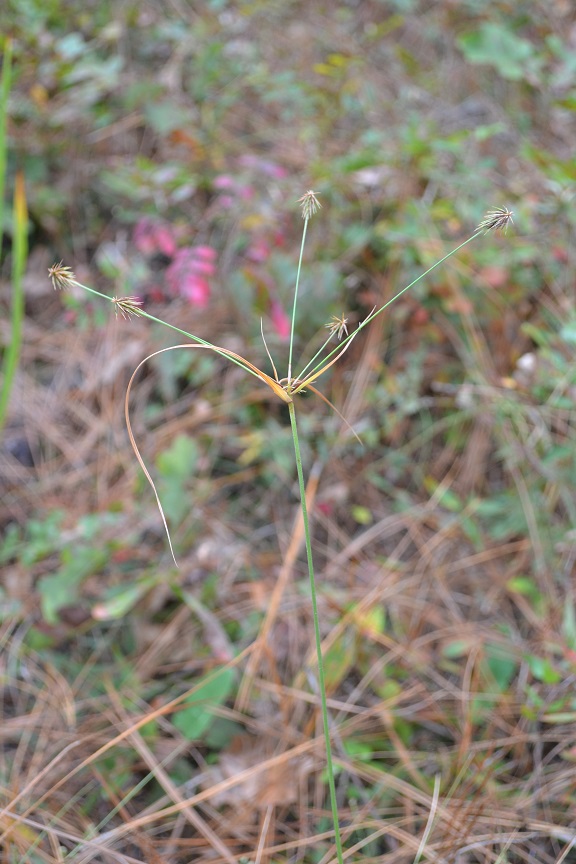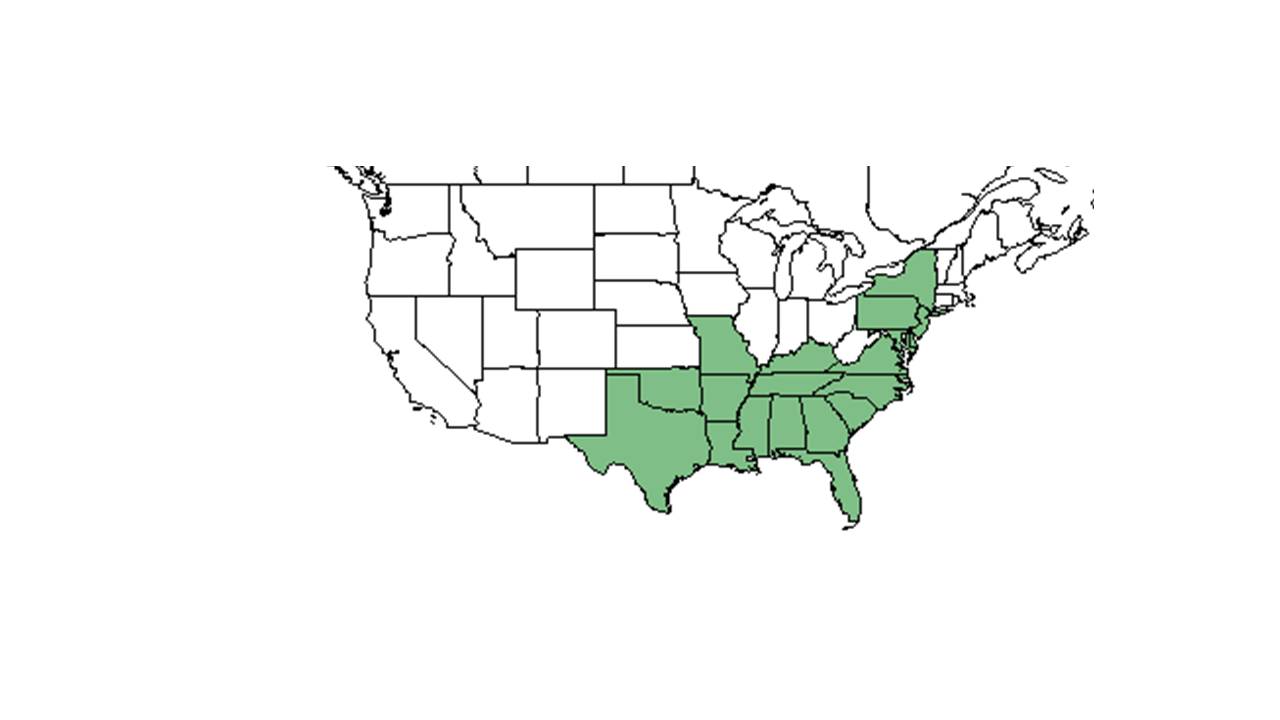Cyperus plukenetii
| Cyperus plukenetii | |
|---|---|

| |
| Photo taken by Kevin Robertson | |
| Scientific classification | |
| Kingdom: | Plantae |
| Division: | Magnoliophyta - Flowering plants |
| Class: | Liliopsida – Monocotyledons |
| Order: | Cyperales |
| Family: | Cyperaceae |
| Genus: | Cyperus |
| Species: | C. plukenetii |
| Binomial name | |
| Cyperus plukenetii Fernald | |

| |
| Natural range of Cyperus plukenetii from USDA NRCS Plants Database. | |
Common name: Plukenet's flatsedge
Contents
Taxonomic notes
Description
A description of Cyperus plukenetii is provided in The Flora of North America. Cyperus plukenetii is a perennial graminoid. Individual plants have numerous stems, each with a cormose base; and the bases are tightly bunched together (FSU Herbarium).
Distribution
Ecology
Habitat
C. plukenetii requires sandy soils.[1] It also prefers higher light levels, from open to semi-open conditions (FSU Herbarium). It is found in sparse scrub woods, woods' edges, and open fields.[2] Other habitat types include dry pine and oak lands, scrub oak sandhills, turkey oak-longleaf pine barrens, open hardwood stands, open upland pine forests, and river banks, but it is infrequent in open stands of longleaf pine and wiregrass (FSU Herbarium). It also has been found in disturbed areas, including bulldozed scrub oak sandhills, cut-over longleaf pine-turkey oak sand ridges and flatwoods, pasture fence lines, young pine plantations, and roadsides (FSU Herbarium).
Associated species include Liatris, Agalinis, Chrysopsis, Aristida stricta, Phoebanthus tenuifolias, Eupatorium album, Pteridium aquilinum var. pseudacaidatum, Serenoa repens, Quercus margaretta, Q. minima, Q. ellottii (FSU Herbarium).
Seed dispersal
It can be dispersed in a variety of ways: rain wash, transport of achenes in mud on feet of migratory waterfowl[3], ingestion of fruits by migratory waterfowl[4], and flotation of achenes (Chermezon 1924; Ridley 1930; Lye 1981)[5]It also uses animals as dispersal agents by attaching to their fur by spikelets[1]
Fire ecology
This species is fire tolerant and has been found on annually burned pinelands (FSU Herbarium).
Conservation and Management
Cultivation and restoration
Photo Gallery
References and notes
Florida State University Robert K. Godfrey Herbarium database. URL: http://herbarium.bio.fsu.edu. Last accessed: June 2014. Collectors: A. H. Curtiss, R. Kral, R.K. Godfrey, Gary R. Knight, George R. Cooley, Richard J. Eaton, R. F. Doren, R L Lazor, V. Sullivan, Holly Maurushat, Richard S. Mitchell, Loran C. Anderson, Andre F. Clewell, and Kevin Oakes. States and Counties: Florida: Calhoun, Duval, Hernando, Jackson, Jefferson, Leon, Liberty, Marion, Okaloosa, Taylor, Wakulla, and Walton. Georgia: Baker, Grady, and Marion.
- ↑ 1.0 1.1 Carter, R. (1993). "Animal dispersal of the North American Sedge, Cyperus plukenetii (Cyperaceae)." American Midland Naturalist 129: 352-356.
- ↑ CARTER, R. 1984. A systematic study of the New World species of section Umbellati of Cyperus. Unpubl. Ph.D. Thesis, Vanderbilt University, Nashville, Tenn. 279 p. Carter, R. (1993). "Animal dispersal of the North American Sedge, Cyperus plukenetii (Cyperaceae)." American Midland Naturalist 129: 352-356.
- ↑ RIDLEY, H. N. 1930. The dispersal of plants throughout the world. L. Reeve & Co., Ltd., Ashford, Kent. 744 p. Carter, R. (1993). "Animal dispersal of the North American Sedge, Cyperus plukenetii (Cyperaceae)." American Midland Naturalist 129: 352-356.
- ↑ RIDLEY, H. N. 1930. The dispersal of plants throughout the world. L. Reeve & Co., Ltd., Ashford, Kent. 744 p. BEND, G. 1937. Eigenartige verbreitung-seinrichtungen bei der Cyperaceen gattung Gahnia. Flora, 131:369-386. Carter, R. (1993). "Animal dispersal of the North American Sedge, Cyperus plukenetii (Cyperaceae)." American Midland Naturalist 129: 352-356.
- ↑ CHERMEZON, H. 1924. Sur la dissemination de quelques Cyperacees. Bull. Soc. Bot. France, 71:849- 861. RIDLEY, H. N. 1930. The dispersal of plants throughout the world. L. Reeve & Co., Ltd., Ashford, Kent. 744 p. LYE, K. A. 1981. Studies in African Cyperaceae 19. The genera of Anosporum Nees and Sorostachys Steudel. Nord. J. Bot., 1:186-191.